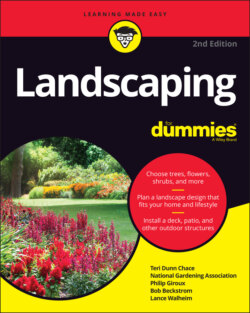Читать книгу Landscaping For Dummies - Lance Walheim - Страница 56
Drawing your own base map
ОглавлениеYou don’t have to be a professional surveyor or landscape architect to draw a base map. Just follow these steps and voilà — your very own base map:
(c) John Wiley & Sons, Inc.
FIGURE 3-1: Basic drafting tools help you draw your plan.
1 Measure the lengths of all edges of your property and draw the outline of your yard on the graph paper.Don’t guess. Refer to Chapter 1 about discovering where the boundaries actually are.
2 Measure and draw in the outline of your house.Be sure to place the house exactly where it sits on your lot.
3 Measure and add the garage, barn, tool shed, chicken coop, and whatever other outbuildings currently exist.Some of the measurements are easy to take, such as the length of building walls, so start there. Then draw in other elements and show their locations in relation to known measurements.
4 Measure and draw in whatever paving is already in place and that you want to keep, such as the driveway, front walk, basketball court, and so on. Don’t assume that right angles and parallel lines that are formed by walls, fences, driveways, and property lines are always perfect — often they aren’t. Verify the distance between objects with as many measurements as you can.
5 Measure and draw existing elements that you want to keep right where they are, with no changes.This may include fences, big trees, hedges, perennials, a vegetable garden, and so forth. For example, indicate the precise location of a tree trunk or plant by measuring the distance from it to two known points, such as two corners of the house. Make note of approximate heights of taller elements. To do so, try this: position a 6-foot (1.8 m) tall person under a tall tree. Back away and estimate: how many of that person will it take to measure to the top?
That’s a lot of measurements, right? Taking measurements may sound like a pain in the neck — and we won’t lie, it is — but you’re far ahead of the game when you get estimates for what this new design is actually going to cost. Without measurements, you’ll have no idea how much concrete, wood chips, topsoil, bricks or paving stones, groundcover plants, or other materials that you’ll need.
Measurements are also vital when adding new elements to your yard. Sure, you can eyeball your yard and make your drawing fit, but when you try to execute the plan, you may find out how fallible that casual method really is. Measurements eliminate guesswork and give you the confidence of knowing that your plan will work.
Invest in a rolling tape measure (100-foot, 30.5 m) to avoid the frustration of marking off 10-foot (3 m), lengths and adding them up to get a reading on your 400-foot (122 m) side boundary. Enlist a helper when you’re ready to measure to make the job go quicker.
